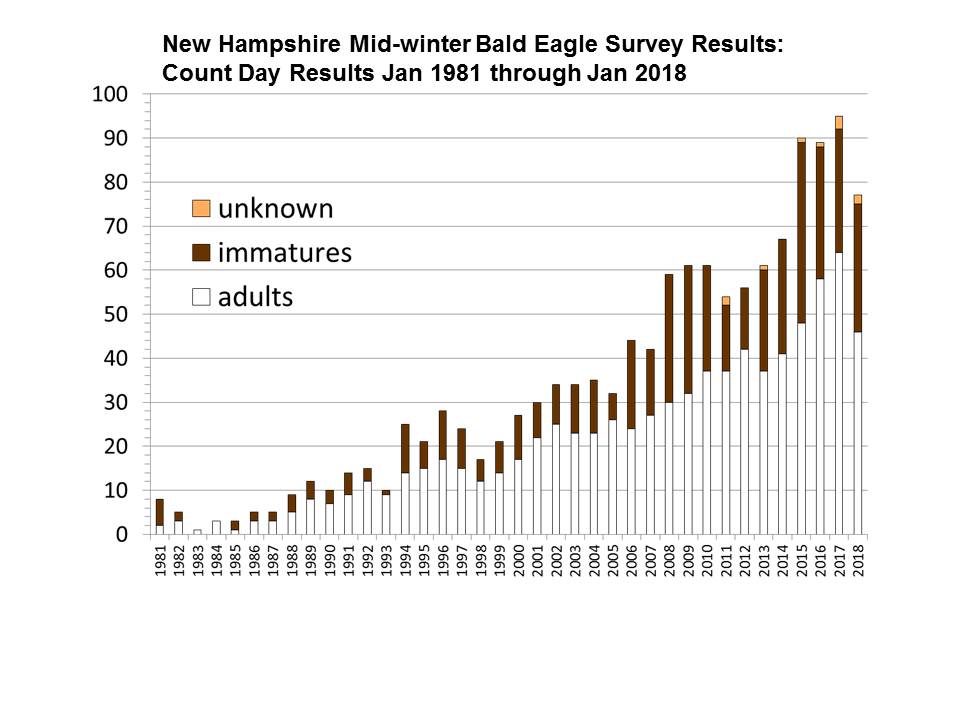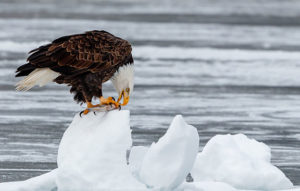by Chris Martin, Senior Biologist
We have just wrapped up the 38th annual New Hampshire Mid-winter Bald Eagle Survey, part of the national Mid-winter Bald Eagle Survey coordinated by the U.S. Geological Survey. Our 2018 count tallied 77 individual Bald Eagles seen across New Hampshire on Count Day. Thursday’s weather for the Lakes Region count on Jan 11th was partly cloudy, fairly mild, and wind-free. Saturday’s weather for the statewide Count Day on Jan 13th was highly variable across the state, with clearing conditions and falling temperatures in the south, but with freezing rain in the west, and snow most of the day up north. As a result, participants were given the option to elect to count on Sunday Jan 14th or Monday Jan 15th. This presented a few more challenges in compiling the data, but enabled folks safely completing their routes. A total of 84 volunteer observers participated in the 2018 Count Day, and located 77 individual eagles on Count Day, about 20% below the record-high of 95 birds seen in 2017. Top regional honors for most eagles seen on Count Day 2018 goes to the Merrimack River watershed where 26 eagles were tallied on Count Day. The Great Bay/Seacoast watershed tallied 18 birds, and the Lakes Region found 16 birds on Count Day. Other regions had lower numbers.

Statewide Count Day Results: This year we located 77 Bald Eagles (46 adults, 29 immatures*, 2 unknown age) in New Hampshire on Count Day, well below totals from recent past counts in 2017 (95 birds), 2016 (89) and 2015 (90).
Statewide Count Period Results: The official “Count Day” occurs within a more inclusive two-week “Count Period,” which this year spanned the interval from January 5-19, 2018. We keep track of eagles seen during this 15-day interval. Any additional individual birds that are reported during the Count Period, and which are obviously different (either by plumage or location) from Count Day birds, are added to calculate an overall Count Period total. During this year’s Count Period, we documented a total of 97 Bald Eagles (58 adults, 37 immatures, 2 unknown age). As for longer-term trends, aside from this year’s drop, the number of eagles counted during the Mid-winter Survey in New Hampshire has been doubling roughly every 10 years; for the 15-day Count Period in 2015 we had 110 eagles, in 2005 we tallied 55 eagles, in 1994 we counted just 25, in 1984 we counted only 12.
So, where were all these eagles found during the 2018 Mid-winter Survey? We located most eagles in the state’s five major watersheds, and in association with nests sites scattered widely across the state:
Androscoggin River – Total of 4 Bald Eagles seen, including 4 individuals (3 adults, 1 immature) seen on Count Day (10 observers), with no additional eagles confirmed during the two-week Count Period.
Connecticut River** – 9 Bald Eagles seen, including 9 individuals (7 adults, 2 immatures) seen on Count Day (14 observers counting for NH’s total), with no additional eagles confirmed during the two-week Count Period.

Great Bay/Coastal – Total of 29 Bald Eagles seen, including 18 individuals (11 adults, 5 immatures, 2 unknown age) seen on Count Day (15 observers), plus 11 additional eagles (4 adults, 7 immatures) confirmed during the two-week Count Period. Stacy Mazur had an immature in Newington.
Lakes Region – Total of 20 Bald Eagles seen, including 16 individuals (13 adults, 3 immatures) seen on Count Day (20 observers), plus 4 additional eagles (3 adults, 1 immature) confirmed during the two-week Count Period. Jack Dorsey found an adult perched in New Hampton, Libby Corbin had another adult in Bristol and a 4th-year immature in Warren.
Merrimack River – Outstanding total of 31 Bald Eagles seen, including 26 individuals (10 adults, 16 immatures) seen on Count Day (22 observers), plus 5 additional eagles (5 adults) confirmed during the two-week Count Period. Scott Heron had a 3rd-year immature in Kingston and Gerry Coffey found 2 adults perched on a pine snag in Manchester.
Saco River/Ossipee River, and from elsewhere across NH – Total of 4 Bald Eagles seen, including 4 individuals (2 adults, 2 immatures) seen on Count Day (3 observers), with no additional eagles confirmed during the two-week Count Period. Pam McGovern had an immature on the Ossipee River.
A FEW NOTES ON TERMINOLOGY:
* Following the standardized rules of the National Mid-winter Bald Eagle Survey, all sub-adult plumage eagles (including those displaying almost full adult plumage but with minor remnants of immature plumage – often called “dirty adults”) are counted as “immatures” rather than as “adults”.
[** To avoid double-counting, VT and NH “partition” the Connecticut River, with VT credited with all eagles seen upstream from Wilder Dam, and NH credited for all eagles seen downstream from the dam, regardless of which state’s volunteers see the birds, or which state the bird was flying over or perched in.]
NH Audubon monitors Bald Eagle abundance and distribution throughout New Hampshire as part of an annual contract with the NH Fish and Game Department’s Nongame and Endangered Wildlife Program. Bald Eagles are now listed as “Special Concern” in New Hampshire since their official removal from NH’s Threatened and Endangered Wildlife List in March 2017. Our monitoring and management work is funded by NH Fish & Game, and by the Dorr Foundation. Additional donations to NH Audubon’s Conservation Department in support of this work are always appreciated. With completion of the 2018 Mid-winter Survey, NH eagle-watchers can turn our attention towards the upcoming eagle breeding season. Just 5-8 weeks from now, most of our breeding pairs will be laying eggs and beginning their 5-week incubation period. Please watch for, and report, any courtship or nesting activity that you may observe as NH Audubon continues to monitor and manage NH’s breeding eagles in collaboration with NH Fish & Game.
Also, see the following video link to how another place with a much higher winter concentration of eagles tallies their birds:
http://www.kwqc.com/content/news/Army-Corps-of-Engineers-rangers-show-us-how-they-count-eagles–468223903.html
Thanks once again to each and every one of you who donated your time and skills to participate in this year’s successful New Hampshire Mid-winter Bald Eagle Survey!
